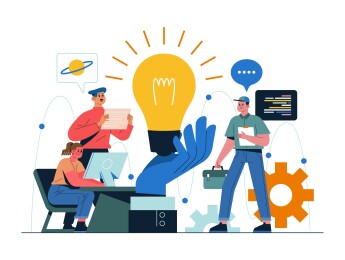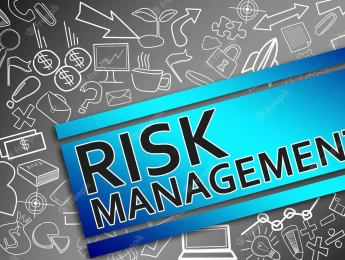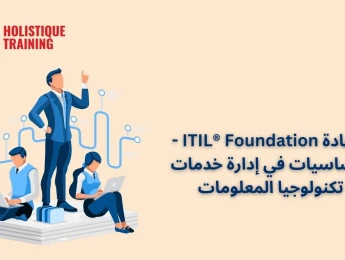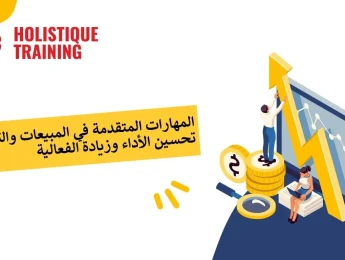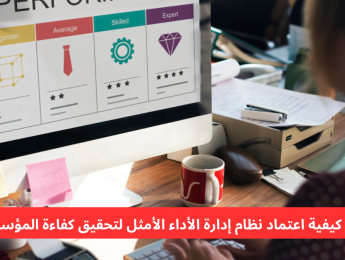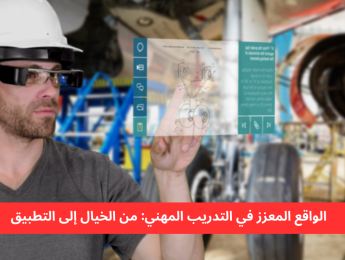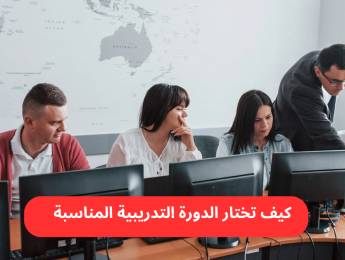- جدول المحتويات
- ما هيالتقنيات الحديثة مع الامثلة
- العلاقة بين التكنولوجيا والتنمية المؤسسية
- ما هو دور التكنولوجيا في تعزيز التنمية في المؤسسات
- تحسين كفاءة العمليات التشغيلية
- تعزيز اتخاذ القرارات المبنية على البيانات
- تسهيل التواصل والتعاون الداخلي
- دعم الابتكار وتطوير المنتجات والخدمات
- مراقبة الأداء وتحقيق التحسين المستمر
- كيف تُعيد التكنولوجيا تشكيل بيئة العمل الحديثة
- التحديات والفرص في بيئة العملالحديثة
- .1التحدي: مقاومة التغيير والتكيف مع التكنولوجيا
- .2الفرصة: تعزيز الإنتاجية والكفاءة
- .3التحدي: الحفاظ على التوازن بين العمل والحياة الشخصية
- .4الفرصة: الابتكار والتطوير المستمر
- .5التحدي والفرصة: إدارة فرق العمل المتنوعة والعالمية
- دور الذكاء الاصطناعي في الابتكار والتنمية في بيئة العمل
تشهد بيئات العمل الحديثة تحولًا جذريًا بفعل التقنيات الحديثة التي أعادت تعريف طرق الإنتاج، التواصل، واتخاذ القرارات داخل المؤسسات. فقد أصبحت الأدوات الرقمية مثل الذكاء الاصطناعي، إنترنت الأشياء، الحوسبة السحابية، والواقع الافتراضي والمعزز جزءًا أساسيًا من عمليات العمل اليومية، مما يتيح تحقيق مستويات أعلى من الكفاءة والدقة. هذه التقنيات لا تسهم فقط في أتمتة المهام الروتينية، بل تعزز أيضًا الابتكار من خلال توفير بيانات دقيقة وتحليلات متقدمة تساعد على تطوير المنتجات والخدمات بشكل مبتكر. علاوة على ذلك، تدعم هذه الأدوات تطوير مهارات الموظفين، وتحسين التعاون بين الفرق متعددة المواقع، ما يخلق بيئة عمل أكثر ديناميكية ومرونة.
ما هي التقنيات الحديثة مع الامثلة
التقنيات الحديثة هي مجموعة من الابتكارات والأدوات الرقمية التي تستخدم لتحسين الكفاءة، زيادة الإنتاجية، وتسهيل حياة الأفراد والمؤسسات في مختلف المجالات. تشمل هذه التقنيات الذكاء الاصطناعي، الذي يمكن استخدامه في تحليل البيانات واتخاذ القرارات بسرعة ودقة، مثل روبوتات الدردشة في خدمة العملاء أو أنظمة التوصية في التجارة الإلكترونية. كما تشمل إنترنت الأشياء (IoT)، الذي يربط الأجهزة والمعدات ببعضها البعض لتبادل المعلومات وإدارة العمليات بشكل ذكي، مثل المنازل الذكية والمصانع الذكية التي تراقب الإنتاج وتوفر الطاقة. كذلك يُعد الواقع الافتراضي (VR)والواقع المعزز (AR)من التقنيات الحديثة، حيث يستخدم الواقع الافتراضي لتوفير تجارب محاكاة ثلاثية الأبعاد في التدريب أو السياحة، بينما يضيف الواقع المعزز معلومات تفاعلية على العالم الحقيقي، مثل تطبيقات الترجمة الفورية أو الإرشاد السياحي. بالإضافة إلى ذلك، تقنيات الحوسبة السحابية توفر تخزينًا آمنًا للبيانات والوصول إليها من أي مكان، مما يدعم الأعمال عن بُعد والتعاون بين الفرق العالمية، كما في منصات مثل Google WorkspaceوMicrosoft Azure.كذلك تُعتبر الطباعة ثلاثية الأبعاد من التقنيات الحديثة التي تغير طرق التصنيع، حيث يمكن إنتاج نماذج وأجزاء دقيقة بسرعة وبتكلفة أقل. هذه التقنيات الحديثة مجتمعة تعزز الابتكار وتفتح آفاقًا جديدة للنمو الاقتصادي والاجتماعي، مع تحسين جودة الحياة وزيادة كفاءة المؤسسات والأفراد على حد سواء، مما يجعلها عناصر أساسية في التحول الرقمي والصناعي المعاصر.
العلاقة بين التكنولوجيا والتنمية المؤسسية
تلعب التكنولوجيا دوراً محورياً في تعزيز التنمية المؤسسية، حيث أصبحت أحد العوامل الأساسية التي تحدد قدرة المؤسسات على التكيف مع التغيرات السريعة في بيئة الأعمال وتحقيق أهدافها الاستراتيجية بكفاءة. فالتقنيات الحديثة، مثل نظم إدارة المعلومات، التحليلات الذكية، والذكاء الاصطناعي، توفر أدوات دقيقة لمتابعة الأداء وتحليل البيانات، ما يساعد الإدارات على اتخاذ قرارات مبنية على أسس علمية وواقعية، بدلاً من الاعتماد على التخمين أو الخبرة الفردية فقط. كما تسهم التكنولوجيا في تحسين التواصل الداخلي بين الموظفين وأقسام المؤسسة، وتسهيل مشاركة المعرفة والخبرات، مما يعزز روح التعاون والعمل الجماعي، ويقلل من الهدر والازدواجية في المهام. بالإضافة إلى ذلك، تعمل الأدوات الرقمية على أتمتة العمليات الروتينية، ما يوفر الوقت والموارد للتركيز على الأنشطة الاستراتيجية والإبداعية، ويزيد من إنتاجيةالموظفين وكفاءتهم. تتيح التكنولوجيا أيضاً تطوير نماذج أعمال مبتكرة، وتحسين جودة الخدمات والمنتجات، بما يلبي توقعات العملاء المتزايدة ويعزز رضاهم وولاءهم. على الصعيد الإداري، تمكّن الأنظمة التكنولوجية المؤسسات من قياس الأداء بشكل مستمر، متابعة مؤشرات النجاح، وتحديد نقاط القوة والضعف بسرعة، ما يدعم عملية التطوير والتحسين المستمر. في المجمل، يمكن القول إن العلاقة بين التكنولوجيا والتنمية المؤسسية ليست مجرد تكامل تقني، بل استراتيجية شاملة تعزز القدرة التنافسية، الابتكار، والكفاءة التشغيلية، وتضع المؤسسة على مسار نمو مستدام يتوافق مع تحديات العصر ومتطلبات السوق الحديثة، مما يجعل الاستثمار في التكنولوجيا أحد الركائز الأساسية لبناء مؤسسات مرنة ومتطورة وقادرة على تحقيق التنمية المستدامة.

ما هو دور التكنولوجيا في تعزيز التنمية في المؤسسات
تحسين كفاءة العمليات التشغيلية
تعمل التكنولوجيا على أتمتة المهام الروتينية وتقليل الأخطاء البشرية. هذا يوفر الوقت والجهد للموظفين للتركيز على الأنشطة الاستراتيجية. كما يقلل الهدر ويزيد من دقة العمليات. النتيجة هي رفع الإنتاجية وتحسين الأداء العام للمؤسسة.
تعزيز اتخاذ القرارات المبنية على البيانات
تمكن أدوات التحليل الذكي وأنظمة إدارة المعلومات من جمع البيانات وتحليلها بسرعة ودقة. هذا يوفر رؤية واضحة عن أداء المؤسسة والسوق والمنافسين. القرارات المستندة إلى البيانات تقلل المخاطر وتزيد من فعالية الاستراتيجيات. كما تساعد على التنبؤ بالتحديات والفرص المستقبلية.
تسهيل التواصل والتعاون الداخلي
توفر التكنولوجيا منصات رقمية لتبادل المعلومات بين الفرق والأقسام المختلفة. هذا يعزز التعاون ويقلل من سوء الفهم والتأخير في نقل المعلومات. كما يتيح مشاركة المعرفة والخبرات بسرعة وسلاسة. النتيجة هي تعزيز العمل الجماعي وتحقيق الأهداف المشتركة بكفاءة أعلى.
دعم الابتكار وتطوير المنتجات والخدمات
تمكن التكنولوجيا المؤسسات من اختبار أفكار جديدة وتصميم منتجات وخدمات مبتكرة. يمكن استخدام المحاكاة الرقمية والذكاء الاصطناعي لتقييم النتائج قبل التطبيق الفعلي. هذا يقلل التكاليف ويزيد من فرص النجاح. كما يعزز قدرة المؤسسة على التكيف مع تغيرات السوق واحتياجات العملاء.
مراقبة الأداء وتحقيق التحسين المستمر
توفر التكنولوجيا أدوات قياس الأداء بشكل دوري ودقيق. تساعد هذه الأدوات على تحديد نقاط القوة والضعف في العمليات والموظفين. كما تتيح وضع خطط تطوير مستمرة وتحسين الإجراءات. هذا يدعم النمو المؤسسي ويضمن تحقيق أهداف التنمية بشكل فعّال ومستدام.
كيف تُعيد التكنولوجيا تشكيل بيئة العمل الحديثة
تعيد التكنولوجيا تشكيل بيئة العمل الحديثة بشكل شامل وعميق، حيث تؤثر على جميع جوانب الحياة المهنية بدءًا من أسلوب التواصل بين الفرق وصولاً إلى إدارة العمليات واتخاذ القرارات الاستراتيجية. أحد أبرز التحولات هو الانتقال من مكاتب العمل التقليدية إلى بيئات مرنة تعتمد على العمل عن بُعد والعمل الهجين، حيث تمكّن أدوات التعاون الرقمية مثل برامج الاجتماعات الافتراضية، منصات إدارة المشاريع، وتطبيقات التواصل الفوري الفرق من التواصل بسلاسة وإنجاز المهام دون الحاجة للتواجد المادي في مكان العمل. هذه الأدوات توفر الوقت وتقلل التكاليف المرتبطة بالتنقل والمكاتب، كما تمنح الموظفين مرونة أكبر توازن بين الحياة المهنية والشخصية، ما يعزز رضاهم وإنتاجيتهم.
علاوة على ذلك، ساهمت التكنولوجيا في تطوير أنظمة إدارة الأداء ومراقبة الإنتاجية، حيث يمكن للقيادات استخدام البيانات الضخمة والتحليلات الذكية لتقييم أداء الموظفين والفرق بشكل مستمر وفوري. هذه المقاربة تتيح اكتشاف نقاط القوة والضعف بسرعة، وتساعد على توجيه الموارد بشكل أفضل لتحقيق أهداف المؤسسة الاستراتيجية. كما أن الأتمتة الرقمية للمهام الروتينية مثل إدخال البيانات، معالجة المستندات، وإعداد التقارير توفر الوقت والجهد، مما يسمح للموظفين بالتركيز على الأعمال الإبداعية والاستراتيجية، ويزيد من كفاءة العمليات التشغيلية.
التكنولوجيا أيضًا تدعم الابتكار من خلال أدوات الذكاء الاصطناعي والتعلم الآلي، حيث يمكن تحليل البيانات الضخمة للتنبؤ بالاحتياجات المستقبلية للسوق، تحسين خدمة العملاء، وتقديم حلول مخصصة للمشكلات اليومية. كما تلعب التكنولوجيا دورًا كبيرًا في تعزيز الاستدامة داخل بيئة العمل، من خلال تقليل الاعتماد على الورق والطاقة، وإدارة الموارد بشكل أكثر كفاءة، واعتماد حلول صديقة للبيئة مثل أنظمة الإضاءة الذكية وإدارة الطاقة عن بعد.
بالإضافة إلى ذلك، توفر الحوسبة السحابية ومنصات التخزين الرقمي إمكانية الوصول إلى البيانات والملفات من أي مكان، مما يسهل التعاون بين الفرق العالمية ويعزز سرعة اتخاذ القرارات. أدوات الواقع الافتراضي والمعزز أيضًا بدأت تلعب دورًا في التدريب العملي والمحاكاة، مما يوفر خبرات تفاعلية أكثر فعالية من الأساليب التقليدية.
في المجمل، تحوّل التكنولوجيا بيئة العمل إلى مساحة ديناميكية ومرنة، تجمع بين الكفاءة الرقمية والقدرة البشرية على الابتكار والإبداع. هذه البيئة الحديثة ترفع مستوى الأداء المؤسسي، تعزز رضا الموظفين، وتمنح المؤسسات القدرة على التكيف السريع مع التغيرات المستمرة في الأسواق، ما يجعلها أكثر استعدادًا لمواجهة تحديات القرن الحادي والعشرين وتحقيق النمو المستدام.

التحديات والفرص في بيئة العملالحديثة
.1التحدي: مقاومة التغيير والتكيف مع التكنولوجيا
تواجه المؤسسات صعوبة في إدخال تقنيات جديدة بسبب مقاومة الموظفين أو نقص المهارات الرقمية. هذا يمكن أن يبطئ من عملية التحول الرقمي ويقلل من فعالية الأدوات الجديدة. يحتاج الأمر إلى تدريب مستمر وبرامج توعية لتسهيل التكيف. كما يجب توفير دعم تقني مستمر للتغلب على المشكلات اليومية. النتيجة بيئة عمل أكثر انسيابية مع اعتماد التكنولوجيا بشكل تدريجي.
.2الفرصة: تعزيز الإنتاجية والكفاءة
توفر التكنولوجيا الحديثة أدوات لأتمتة المهام الروتينية وتحليل البيانات بشكل سريع ودقيق. هذا يتيح للموظفين التركيز على الأعمال الإبداعية والاستراتيجية. كما تساهم منصات التعاون الرقمي في تسريع إنجاز المشاريع وتقليل الأخطاء. زيادة الكفاءة تؤدي إلى تحقيق أهداف المؤسسة بشكل أسرع وأكثر دقة. النتيجة هي رفع الإنتاجية وتحسين الأداء العام للمؤسسة.
.3التحدي: الحفاظ على التوازن بين العمل والحياة الشخصية
المرونة الكبيرة في العمل عن بُعد قد تؤدي إلى زيادة ساعات العمل والضغط النفسي على الموظفين. صعوبة الفصل بين الحياة المهنية والشخصية قد تؤثر سلبًا على الصحة النفسية والإنتاجية. تحتاج المؤسسات إلى سياسات واضحة لإدارة الوقت وتحديد أوقات العمل والراحة. دعم الموظفين من خلال برامج الصحة النفسية يسهم في التوازن. النتيجة تعزيز رضا الموظفين واستدامة الأداء على المدى الطويل.
.4الفرصة: الابتكار والتطوير المستمر
بيئة العمل الحديثة توفر منصات للتعلم المستمر وتطوير المهارات الرقمية والإبداعية. أدوات الذكاء الاصطناعي وتحليل البيانات تمكن المؤسسات من اتخاذ قرارات مبتكرة. كما تسهل تجربة أساليب جديدة في المنتجات والخدمات بسرعة. هذا يعزز القدرة التنافسية ويدعم النمو المستدام. النتيجة هي ثقافة عمل قائمة على الابتكار والتحسين المستمر.
.5التحدي والفرصة: إدارة فرق العمل المتنوعة والعالمية
العمل عن بُعد والتوسع العالمي يعزز التنوع الثقافي والمهارات المتنوعة داخل الفرق. التحدي يكمن في التنسيق بين فرق مختلفة المواقع والثقافات وإدارة التواصل بفعالية. باستخدام أدوات التعاون الرقمية واستراتيجيات الإدارة المناسبة، يمكن تحويل التنوع إلى ميزة تنافسية. هذه البيئة توفر فرصًا لتبادل الخبرات ووجهات النظر المختلفة. النتيجة هي فرق أكثر مرونة وإبداعًا قادرة على مواجهة تحديات السوق المتغيرة.
دور الذكاء الاصطناعي في الابتكار والتنمية في بيئة العمل
يلعب الذكاء الاصطناعي دورًا محوريًا في تعزيز الابتكار والتنمية داخل بيئة العمل الحديثة من خلال تحويل طرق التفكير وإدارة العمليات بشكل جذري. فهو يتيح تحليل كميات ضخمة من البيانات بسرعة ودقة، ما يمكن المؤسسات من التعرف على الفرص والمشكلات قبل حدوثها، واتخاذ قرارات استراتيجية مبنية على معلومات موثوقة. كما يسهم في أتمتة المهام الروتينية والمتكررة، مثل معالجة البيانات وإعداد التقارير، مما يوفر الوقت للموظفين للتركيز على الأعمال الإبداعية والاستراتيجية. في جانب الابتكار، يدعم الذكاء الاصطناعي تطوير منتجات وخدمات جديدة من خلال التنبؤ بالاتجاهات السوقية، وتحليل سلوك العملاء، وتصميم حلول مخصصة وفق الاحتياجات الفردية، ما يعزز القدرة التنافسية للمؤسسات. بالإضافة إلى ذلك، يمكن استخدام تقنيات التعلم الآلي والتعلم العميق في تطوير برامج تدريبية ذكية للموظفين، تساهم في رفع كفاءتهم وتحسين مهاراتهم بما يتماشى مع متطلبات السوق. كما يعزز الذكاء الاصطناعي القدرة على التعاون بين الفرق من خلال أدوات ذكية للتواصل وتحليل أداء المشاريع، ما يسهل التنسيق وإدارة الفرق متعددة المواقع بفعالية أكبر. على مستوى التنمية المؤسسية، يتيح الذكاء الاصطناعي متابعة الأداء بشكل مستمر، تحديد الفجوات، وتقديم التغذية الراجعة الفورية، مما يحفز التعلم والتحسين المستمر. بهذا الشكل، يصبح الذكاء الاصطناعي ليس مجرد أداة تقنية، بل عنصرًا استراتيجيًا يدمج بين الكفاءة الرقمية والابتكار البشري، مما يخلق بيئة عمل ديناميكية، مرنة، وقادرة على تحقيق النمو المستدام وتحسين الأداء العام للمؤسسة.
في النهاية، يمثل دمج التقنيات الحديثة في بيئة العمل ركيزة أساسية لتعزيز الابتكار والتنمية المؤسسية. فهي توفر أدوات ذكية تساعد على تحسين الأداء،تطوير مهارات الموظفين، واتخاذ قرارات استراتيجية أكثر دقة. المؤسسات التي تتبنى هذه التقنيات تستفيد من ميزة تنافسية قوية، وتكون أكثر قدرة على مواجهة التحديات المستمرة في السوق المعاصر. بذلك، لا تقتصر أهمية التقنيات الحديثة على زيادة الإنتاجية فحسب، بل تمتد لتطوير ثقافة الابتكار المستدامة التي تضمن نموًا متوازنًا وتحقيق أهداف المؤسسة على المدى الطويل.


